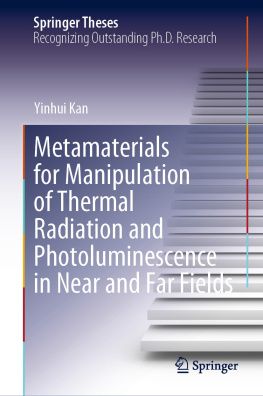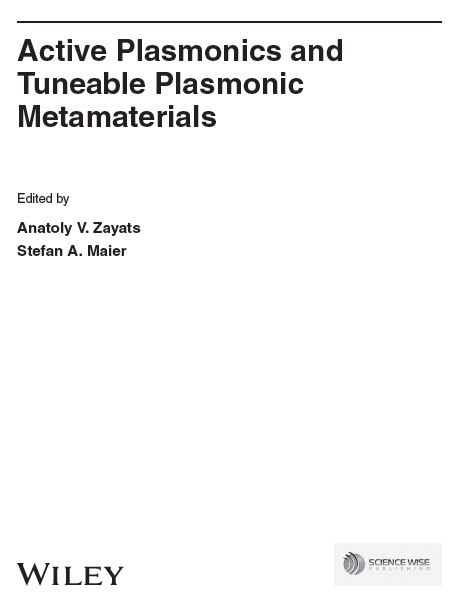Copyright 2013 by John Wiley & Sons, Inc. All rights reserved.
Co-Published by John Wiley & Sons, Inc., and ScienceWise Publishing Hoboken, New Jersey.
Published simultaneously in Canada.
No part of this publication may be reproduced, stored in a retrieval system, or transmitted in any form or by any means, electronic, mechanical, photocopying, recording, scanning, or otherwise, except as permitted under Section 107 or 108 of the 1976 United States Copyright Act, without either the prior written permission of the Publisher, or authorization through payment of the appropriate per-copy fee to the Copyright Clearance Center, Inc., 222 Rosewood Drive, Danvers, MA 01923, (978) 750-8400, fax (978) 750-4470, or on the web at www.copyright.com . Requests to the Publisher for permission should be addressed to the Permissions Department, JohnWiley & Sons, Inc., 111 River Street, Hoboken, NJ 07030, (201) 748-6011, fax (201) 748-6008, or online at http://www.wiley.com/go/permission .
Limit of Liability/Disclaimer of Warranty: While the publisher and author have used their best efforts in preparing this book, they make no representations or warranties with respect to the accuracy or completeness of the contents of this book and specifically disclaim any implied warranties of merchantability or fitness for a particular purpose. No warranty may be created or extended by sales representatives or written sales materials. The advice and strategies contained herein may not be suitable for your situation. You should consult with a professional where appropriate. Neither the publisher nor author shall be liable for any loss of profit or any other commercial damages, including but not limited to special, incidental, consequential, or other damages.
For general information on our other products and services or for technical support, please contact our Customer Care Department within the United States at (800) 762-2974, outside the United States at (317) 572-3993 or fax (317) 572-4002.
Wiley also publishes its books in a variety of electronic formats. Some content that appears in print may not be available in electronic formats. For more information about Wiley products, visit our web site at www.wiley.com .
Library of Congress Cataloging-in-Publication Data:
Active plasmonics and tuneable plasmonic metamaterials / edited by Anatoly V. Zayats, Stefan A. Maier.
pages cm
Includes bibliographical references and index.
ISBN 978-1-118-09208-8 (hardback)
1. Plasmons (Physics) 2. Metamaterials. I. Zayats, A. V. (Anatoly V.), editor of compilation.
II. Maier, Stefan A., editor of compilation.
QC176.8.P55A32 2013
530.44dc23
2012047943
Preface
Plasmonics provides unique advantages in all areas of science and technology where the manipulation of light at the nanoscale is a prominent ingredient. It relies on light-driven coherent oscillations of electrons near a metal surface, called surface plasmons, which can trap electromagnetic waves at subwavelength and nanoscales. Thus, light can be efficiently manipulated using these plasmonic excitations. In recent years, nanostructured metals have allowed unprecedented control over optical properties and linear as well as nonlinear optical processes. As a consequence, nanoplasmonics has become a major research area and is making important advances in several main fields of applications, such as information technologies, energy, high-density data storage, life sciences, and security. In parallel, in the field of metamaterials, plasmonic composites are indispensable for achieving new optical properties in the visible and infrared spectral range, such as negative refractive index, super-resolution, and cloaking. Various types of metamaterials based on split-ring resonators, fishnet-type structures, nanorods, and others have been proposed in the whole spectral range, from microwaves to visible wavelengths. A variety of passive plasmonic elements such as mirrors, lenses, waveguides, and resonators have been demonstrated. After these initial successes, the development of active plasmonic elements capable of controlling light on the nanoscale dimensions with external electronic or optical stimuli is now on the agenda. For example, the availability of tuneable metamaterials with optical properties controlled by the external signals will immensely broaden their possible field of applications.
The number of research publications in both passive and active plasmonics and metamaterials is growing very fast. We felt that it is important to provide for readers interested in these fields a one-stop shop with information on the fundamentals and the state of the art in this field. Active plasmonics and metamaterials are fastmoving fields of research and we could not possibly provide exhaustive coverage of all topics in this field. Instead, this book contains chapters from world-leading authorities in the field, covering active plasmonics from basic principles to the most recent application breakthroughs. The former covers quantum and nonlinear plasmonics, amplification of plasmonic signals and spasers, transformation optics for design of plasmonic nanostructures, active and nonlinear plasmonic metamaterials, and light control via designed phase discontinuities. The latter includes integrated plasmonic detectors, subwavelength imaging with anisotropic metamaterials, tuneable plasmonic lenses, as well as terahertz plasmonic surfaces for sensing.
The book begins with a review of gain in nanoplasmonics. This includes topics such as the spaser and plasmonic gain, amplification, and loss compensation. Both fundamental theoretical concepts and experimental developments have been reviewed. In Chapter 2, physical mechanisms responsible for nonlinearities in plasmonic nanostructures are discussed. Nonlinear surface plasmon polaritons, plasmon solitons, and nonlinear waveguide devices are presented, together with a survey of nonlinearities enhanced by localized surface plasmons and nanoantennas. Plasmonic nanorod metamaterials are introduced in Chapter 3: their optical properties as well as active and nonlinear properties allow tuneable optical responses. Transformation optics provides an extremely powerful tool for designing plasmonic nanostructures with a desired optical response, such as broadband light harvesting and nanofocusing structures, as well as cavities tailored for fluorescence enhancement in the vicinity of complex nanostructures. This new toolkit, as well as the impact of nonlocality on the optical properties of complex plasmonic nanostructures, is presented in Chapter 4.
The next chapter, building on the theoretical paradigms discussed earlier, reviews work conducted on SPP loss compensation and amplification in various types of SPP waveguides. Chapter 6 introduces the principles of light control via phase response engineering in plasmonic antennas. Generalized laws of reflection and refraction in the presence of linear interfacial phase distributions, demonstrations of giant and tuneable birefringence, and generation of optical vortices that carry orbital angular momentum are discussed. The integration of various types of nanoscale photodetectors with plasmonic waveguides and nanostructures is overviewed in Chapter 7. The adaptation of plasmonic concepts from the optical region of the spectrum to the THz band is briefly surveyed from the point of view of sensing applications in Chapter 8. The plasmonic guiding modalities in spectral range are realized either with semiconductors or via patterned metal surfaces. This chapter concludes with a description of possibilities offered by the exciting new material, graphene. A detailed review of subwavelength imaging using extremely anisotropic media in the canalization regime is presented in Chapter 9. Finally, Chapter 10 presents an overview of planar plasmonic diffractive focusing devices. The imaging properties of such plasmonic lenses can be externally tuned by controlling refractive index of the dielectric components of the nanostructure.











